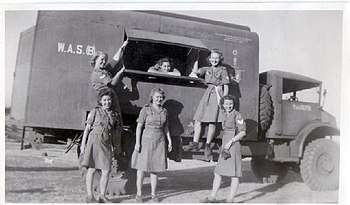Women's Auxiliary Service (Burma)
The Women's Auxiliary Service (Burma) (WAS(B)) also known as the Chinthe Women because of the mythological creature that formed their badge.[1][2] The unit was formed on 16 January 1942 and disbanded in 1946. They were a 250 strong group of British and Australian women who manned Mobile Canteens for the troops of Burma Command in World War II. They were founded and led by Mrs Ninian Taylor, who was granted the rank of Major and her services were an OBE for her services [3] [4]

The unit moved through Burma with the British Fourteenth Army running mobile canteens providing "char & wads".[5][6] living in dangerous and uncomfortable conditions, sleeping in bombed out, rat infested houses or tents with their stores and equipment brought in by air.[7] They improvised stoves from old ammunition boxes. They were evacuated from Myitkyina on the last plane, and from the Battle of Imphal during the siege, but returned as soon as the Japanese retreated, eventually reaching Japan with the British Commonwealth Occupation Force.
Many were mentioned in dispatches. General Slim later 1st Viscount Slim, Commander of the 14th Army known as the "Forgotten Army", said of them "They showed the highest standard of devotion and courage." Lieutenant General Sir Oliver Leese referred to them as "the biggest single factor affecting the moral of the forward troops"[8]
Reference
- Childs, David (22 September 2008). Growing Remembrance: The Story of the National Memorial Arboretum. Pen and Sword. ISBN 1844685985.
- Joffe, Sally and Lucy. CHINTHE WOMEN, Women's Auxiliary Service (Burma) 1942-46. wealth of personal stories about this unique band of women operating in a war zone,http://www.tenterbooks.com/chinthe.html. Tenter books. pp. all.
- Adie, Kate (2 August 2004). Corsets To Camouflage: Women and War. UK: Hachette UK. ISBN 184894361X.
- Taylor, Ninian (27 October 1942). "Supplement to the London Gazette:Members of the Military Division of the said Most Excellent Order" (PDF). Supplement to the London Gazette.
- Dinan, Jacqueline (1 March 2015). Between the Dances, WW2 Woman tell their Stories. Australia: Simon and Schuster. ISBN 9781925183030.
- "WOMEN OF THE WOMEN'S AUXILIARY SERVICE (BURMA) AT SHILLONG. WAS(B) women dishing out refreshments to soldiers at a mobile canteen; they wear the sword and shield patch of the 14th Army. The soldiers are from a Scottish regiment. FILM No: JFU 150". Imperial war Museum (IMW) film archive. 1 September 1944.
- Cheverton, Elaine. "Elaine Cheverton; British NCO served with Women's Auxiliary Service (Burma) in India, Burma and Japan, 1942-1946". Imperial War Museum (IWM). Oral history.
- Childs, David (22 September 2008). Growing Remembrance. Pen and Sword. pp. Chapter 4. ISBN 1844685985.